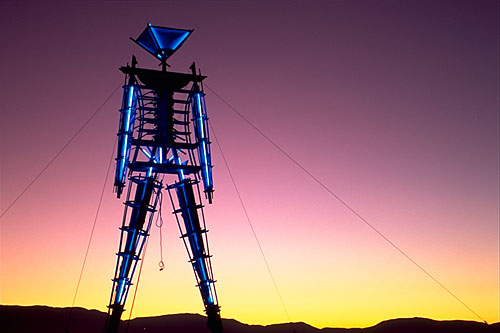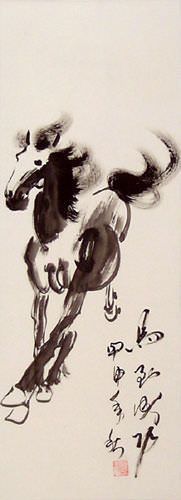Philosophy of Fear
/ Imagine you are a wolf, or some other predator, who is absolutely terrified. Not just passing fear, but the kind of fear that colors everything. Tree branches could fall on you at at any moment, the sun burns and dehydrates, the night freezes. Even the air you breath is frightening.
Imagine you are a wolf, or some other predator, who is absolutely terrified. Not just passing fear, but the kind of fear that colors everything. Tree branches could fall on you at at any moment, the sun burns and dehydrates, the night freezes. Even the air you breath is frightening.When you enter a fight, it is with total fear. You must kill to survive, but because everything is experienced through fear, nothing is treasured, and there is nothing to defend. You fight because you are afraid, but you are no more afraid of this opponent than you are of your own mother.
The entire universe is out to get you. Because every centimeter of your being is fear, there is no way to tense up. Fear has already permeated everything.
This is one path to Dao. It is the path of the Shaman-warrior, who charges off into battle, Baguazhang style, with a deadly poisonous five-steps-down snake in each hand.
Contrast all this with total transcendence. The vision you hold of the cosmos has become so expansive that the entire human race's existence is less than a mite on a fleas ear. You experience yourself, not in terms of your own birth and death, but as part of this gigantic, unfathomable, limitlessness.
For you a fight is no different than walking or riding a bicycle. You are utterly fearless because your own death is no more significant than anyone, or anything, else's. Because your detachment is so complete, you have nothing to defend.
This is another path to Dao. It is the path of perfection, it is how gods are made.
What if you didn't know why you are here? or where you are going? What if fear came up and then dispersed easily? What if transcendence came and went like the clouds? What if not knowing were actually the only constant? What if you were just normal?
When you fight it is a dance. You treasure every bit of flying dust, every rotating muscle, the ground and the sky. You use no technique at all. Because you accept not being able to control the future, you have no need for intermediaries, like technique, strategy, or even hope. Your only tool is intimacy.
This is called the path of wuwei, it is also a path to Dao.
"You have no doubt heard of those who are good at nourishing life."

 I'm working on some posts about fear, but they aren't finished yet.
I'm working on some posts about fear, but they aren't finished yet. I have said before that most medicine comes from war.
I have said before that most medicine comes from war. nd too often was secret. There is also a long tradition of publishing best practices.
nd too often was secret. There is also a long tradition of publishing best practices. . For instance, a liver that doesn't move like a jellyfish when active, will slowly, over years, change the shape and alignment of the bones. An injury to the neck will effect the dexterity of the hand.
. For instance, a liver that doesn't move like a jellyfish when active, will slowly, over years, change the shape and alignment of the bones. An injury to the neck will effect the dexterity of the hand. The T'ai Chi Boxing
The T'ai Chi Boxing  I often hear the bridge metaphor in martial arts talk. It has a number of different meanings.
I often hear the bridge metaphor in martial arts talk. It has a number of different meanings.  becomes a self supporting woven structure, which is both strong and quite flexible.
becomes a self supporting woven structure, which is both strong and quite flexible.


 a cup of tea and hanging out with you.
a cup of tea and hanging out with you. One of the biggest challenges of being a teacher is that students are always trying to get me to equivocate. For instance, I say, "Practice standing completely still for one hour early in the morning, everyday, before you eat breakfast."
One of the biggest challenges of being a teacher is that students are always trying to get me to equivocate. For instance, I say, "Practice standing completely still for one hour early in the morning, everyday, before you eat breakfast." for purity and perfection. During the Sung and Ming dynasties the Chinese government gave out official titles to Orthodox Daoists. (Actually, even at times when the government had an anti-Daoist outlook, Daoshi, invested priests, had the status of "prince" if they were dragged into a magistrate's court. When the British won capitulation at the end of the Opium Wars, one of their demands was that Christian Missionaries be given the same status in court as Daoists. This was later one of the grievances of the Boxer rebellion.)
for purity and perfection. During the Sung and Ming dynasties the Chinese government gave out official titles to Orthodox Daoists. (Actually, even at times when the government had an anti-Daoist outlook, Daoshi, invested priests, had the status of "prince" if they were dragged into a magistrate's court. When the British won capitulation at the end of the Opium Wars, one of their demands was that Christian Missionaries be given the same status in court as Daoists. This was later one of the grievances of the Boxer rebellion.)
 subject,
subject,